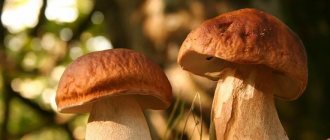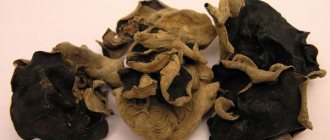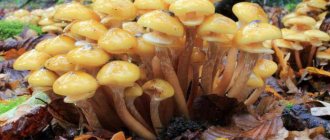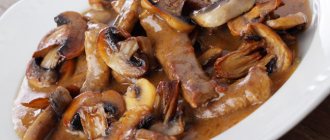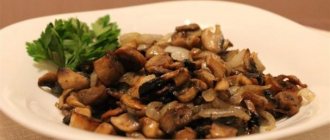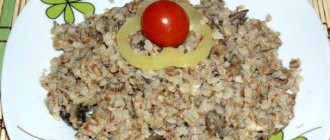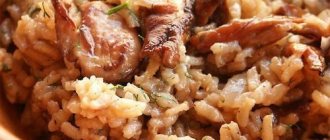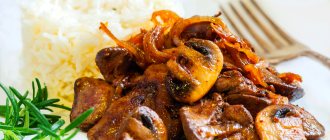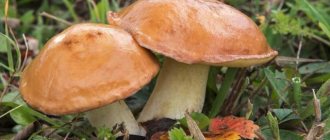Fresh mushrooms belong to the category of necessary products for vegetarian and dietary nutrition. Especially useful for those who are on a diet aimed at losing weight. They contain large quantities of plant protein. This product can easily replace meat dishes. The nutritional value of the diet will not change. Mushrooms are used as a main independent dish, and as an ingredient for salads, cold and hot appetizers, first and second courses. They can be included in the regular daily menu or consumed while fasting.
Harm of fresh mushrooms
Fresh mushrooms are a relatively harmless product, provided they are grown correctly. This product, like a washcloth, absorbs all harmful elements from the environment. Therefore, if you consume mushrooms that have grown in the wild, the risk of poisoning increases. Dishes made from mushrooms place additional stress on the organs of the digestive system, so it is not recommended to introduce them into the diet of children and people with gastrointestinal pathologies.
| Product | Kcal | Proteins, g | Fats, g | Angle, g | |
| Truffles | 24 | 3 | 0,5 | 2 | |
| Russula | 19 | 1,7 | 0,7 | 1,5 | |
| Boletus | 22 | 3,3 | 0,5 | 1,2 | |
| boletus | 20 | 2,1 | 0,8 | 1,2 | |
| Winter honey mushrooms, raw | 44 | 2,56 | 0,32 | 4,98 | |
| Grifola curly, raw | 31 | 1,94 | 0,19 | 6,97 | |
| Champignon mushrooms, raw | 27 | 2,5 | 0,1 | 3,52 | |
| Portobella mushrooms, raw | 26 | 2,5 | 0,2 | 3,57 | |
| Oyster mushroom, raw | 43 | 3,31 | 0,41 | 4,17 | |
| White mushroom, raw | 22 | 3,09 | 0,34 | 2,28 | |
| Auricularia ear-shaped, raw | 25 | 0,48 | 0,04 | 6,75 | |
| Honey mushrooms are spicy | 110 | 2 | 9,5 | 4,3 | |
| Matsutake mushroom | 28 | 3,9 | 0,7 | 1 | |
| Volushka mushrooms | 22 | 2,5 | 0,5 | 1,7 | |
| Serushka mushroom | 18,5 | 1,8 | 0,8 | 1,1 | |
| Ivyshen (Podvishennik) | 0 | 0 | 0 | 0 | |
| Common dubovik | 34 | 3,7 | 1,7 | 1,1 | |
| May mushroom | 19 | 1,7 | 0,7 | 1,5 | |
| White steppe mushroom (Eringi) | 43 | 3,31 | 0,41 | 4,17 | |
| Puff mushroom | 27 | 4,3 | 1 | 1 | |
| Semi-white mushroom | 34 | 3,7 | 1,7 | 1,1 | |
| Caesar mushroom | 19 | 1,7 | 0,7 | 1,5 | |
| Pluteus deer | 19 | 1,7 | 0,7 | 1,5 | |
| Yellow hedgehog | 30 | 3,7 | 1,7 | 1,1 | |
| Royal honey mushrooms (Golden scale) | 22 | 2,2 | 1,2 | 0,5 | |
| Mushroom cabbage (Sparassis curly) | 30 | 3,7 | 1,7 | 1,1 | |
| Petsitsa | 22,7 | 2,9 | 0,4 | 2 | |
| Hygrofor | 0 | 0 | 0 | 0 | |
| Winter honey fungus | 22 | 2,2 | 1,2 | 0,5 | |
| Wet purple | 19,2 | 0,9 | 0,4 | 3,2 | |
| Polish mushroom | 19 | 1,7 | 0,7 | 1,5 | |
| Ram mushroom | 30 | 3,7 | 1,7 | 1,1 | |
| Mushroom talker | 30 | 3,7 | 1,7 | 1,1 | |
| Wood mushroom muer | 10 | 10 | 0 | 2 | |
| Shimeji | 43 | 3,31 | 0,41 | 4,17 | |
| Row mushrooms | 19 | 1,7 | 0,7 | 1,5 | |
| Royal oyster mushroom | 43 | 3,31 | 0,41 | 4,17 | |
| Mushroom raincoat | 27 | 4,3 | 1 | 1 | |
| Portobello mushrooms | 22 | 2,11 | 0,35 | 2,57 | |
| Maitake mushroom | 31 | 1,94 | 0,19 | 4,27 | |
| Moon mushrooms | 30 | 4,8 | 0 | 2,4 | |
| Moss mushroom | 19 | 1,7 | 0,7 | 1,5 | |
| Enoki mushrooms | 42 | 2,7 | 0,41 | 0,22 | |
| Frozen mushrooms | 23 | 2,7 | 1 | 0,9 | |
| Hedgehog mushroom | 30 | 3,7 | 1,7 | 1,1 | |
| Birch chaga mushroom | 20 | 2,1 | 0,8 | 1,2 | |
| Nameko mushrooms | 22 | 2,2 | 1,2 | 0,5 | |
| Shiitake | 34 | 2,2 | 0,5 | 6,8 | |
| Chernushka | 9,1 | 1,5 | 0,3 | 0,1 | |
| Truffle | 24 | 3 | 0,5 | 2 | |
| Russula | 19 | 1,7 | 0,7 | 1,5 | |
| Morel | 22,7 | 2,9 | 0,4 | 2 | |
| Ryzhik | 22,3 | 1,9 | 0,8 | 2 | |
| Boletus | 22 | 3,3 | 0,5 | 1,2 | |
| boletus | 20 | 2,1 | 0,8 | 1,2 | |
| Champignon | 27 | 4,3 | 1 | 1 | |
| Honey mushrooms | 22 | 2,2 | 1,2 | 0,5 | |
| Butter | 19,2 | 0,9 | 0,4 | 3,2 | |
| Chanterelles | 19 | 1,5 | 1 | 1 | |
| Gruzd | 18,5 | 1,8 | 0,8 | 1,1 | |
| Porcini | 34 | 3,7 | 1,7 | 1,1 | |
| Oyster mushrooms | 35 | 3,34 | 0,44 | 6,43 | |
| Portabella mushrooms | 26 | 2,5 | 0,2 | 5,07 | |
| Mushrooms Sliced | 22 | 3,09 | 0,34 | 3,28 | |
| Mushrooms | 22 | 3,09 | 0,34 | 3,28 |
Chemical composition and nutritional value
The nutritional value of mushrooms directly depends on their age. Young plants are the most delicious and nutritious. They contain a high content of enzymes, vitamins, and mineral salts. Older plants retain less valuable nutrients and inorganic compounds. They are practically useless.
The chemical composition of mushrooms is truly unique. 90-95% is water, the rest is dry matter. Among them are the enzymes amylase, lipase, proteinase, and oxidoreductase. Edible plants also contain a lot of vitamins A, group B, C, D, PP, and also:
- 70% of dry matter is protein, which is why the plants are even called “forest meat.” This is an indispensable product for vegetarians.
- In terms of composition and amount of carbohydrates, mushrooms are close to plants. However, they still contain insulin, dextrin, and glycogen.
- In terms of vitamin content, mushrooms overtake liver and yeast, but many of them are destroyed during heat treatment. This primarily concerns carotene and vitamin C.
- The mineral content in edible plants is low, but sufficient to saturate the body with potassium, phosphorus, and iron. There is little calcium in these plants. But it will be well absorbed if you add sour cream or milk to the mushroom dish. Small amounts of iodine, copper, magnesium and zinc are also beneficial to the body, as these trace elements are involved in cellular metabolism.
The calorie content of mushrooms is low. It varies between 10-34 Kcal per 100 g of product. The most calories are in porcini mushrooms, the least in nigella mushrooms. The calorie content of dried and salted mushrooms is about 24 Kcal per 100 g of product.
Simple vegetable recipes for baby food
Vegetable casserole
Required:
- medium size potatoes;
- tomato - 1 pc.;
- minced meat - 30 g;
- soft cottage cheese - 1/2 teaspoon;
- dill, salt - to taste;
- olive oil - 1 tsp. spoon;
- breadcrumbs.
Peel and cut the potatoes into pieces, boil for 10 minutes, drain the water. Pour boiling water over the tomato, remove the skin, remove the seeds, and cut the pulp into pieces. Fry minced meat in olive oil. Crush the potatoes and mix with cottage cheese. Place minced meat, tomatoes, potatoes in layers in a greased form with vegetable oil, and sprinkle breadcrumbs on top. Bake in the oven for 10 minutes. You can sprinkle the casserole with finely chopped dill on top.
We create a menu using vegetables
Children from 1 to 3 years old should receive 200 g of vegetables per day (cabbage, cucumbers, tomatoes, carrots, beets, herbs, etc.), which are used for preparing first courses, side dishes, salads, vinaigrettes, casseroles.
When eating vegetables, it is very important to adhere to certain rules for their culinary processing; only in this case can the desired result be achieved - maximum preservation of the nutritional value of products, improvement of their taste and absorption by the body. During the mechanical and thermal processing of vegetables, they are exposed to the destructive forces of the environment - water, oxygen, ultraviolet radiation, and oxidative enzymes contained in plant cells. Under their influence, many minerals and vitamins, organic acids and aromatic substances are washed out, oxidized and destroyed. Therefore, it is important to use all known methods to reduce the loss of precious nutrients.
It is better to use freshly cut vegetables in the diet of both adults and children. If this is not possible, then purchased products should be stored in a cool place without access to the destructive effects of ultraviolet radiation. Vegetables should be washed under running cool water, briefly, without soaking.
It is better to cook vegetables, like other foods, with their skins on, immersing them in boiling water. You should not boil vegetables for a long time: any heat treatment destroys vitamins.
You should also not make preparations for vegetable salads (cut vegetables in advance): cut vegetables oxidize in the air and vitamin C is destroyed. In the warm season, microbial contamination of preparations is possible, and, as a result, after using such dishes - an acute intestinal infection.
Advertising
